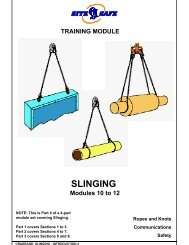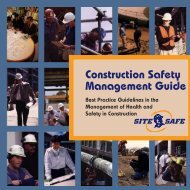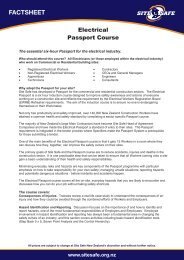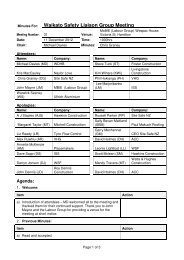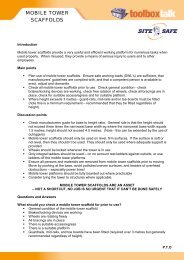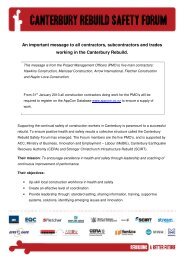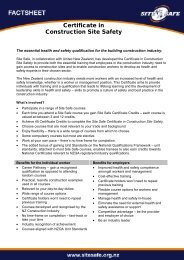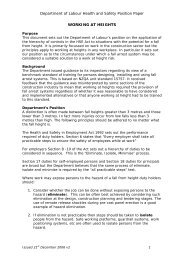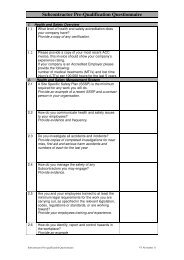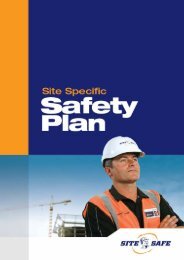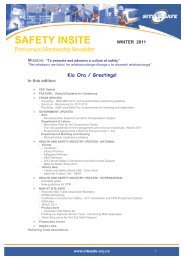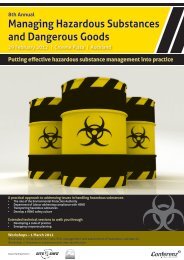Health and Safety Guide for the Tendering Process - Site Safe
Health and Safety Guide for the Tendering Process - Site Safe
Health and Safety Guide for the Tendering Process - Site Safe
You also want an ePaper? Increase the reach of your titles
YUMPU automatically turns print PDFs into web optimized ePapers that Google loves.
<strong>Health</strong> <strong>and</strong> <strong><strong>Safe</strong>ty</strong><br />
<strong>Guide</strong> <strong>for</strong> <strong>the</strong> <strong>Tendering</strong><br />
<strong>Process</strong><br />
Best Practice <strong>Guide</strong>lines <strong>for</strong><br />
<strong>Health</strong> <strong>and</strong> <strong><strong>Safe</strong>ty</strong> in <strong>the</strong><br />
Construction <strong>Tendering</strong> <strong>Process</strong><br />
<strong>Health</strong> <strong>and</strong> <strong><strong>Safe</strong>ty</strong> <strong>Guide</strong> <strong>for</strong> <strong>the</strong> <strong>Tendering</strong> <strong>Process</strong> 2
Published by <strong>Site</strong> <strong>Safe</strong> New Zeal<strong>and</strong><br />
Level 5, Anvil House<br />
138-140 Wakefield Street<br />
Wellington<br />
New Zeal<strong>and</strong><br />
First Edition: March 2000<br />
ISBN 0-473-06655-6<br />
<strong>Health</strong> <strong>and</strong> <strong><strong>Safe</strong>ty</strong> <strong>Guide</strong> <strong>for</strong> <strong>the</strong> <strong>Tendering</strong> <strong>Process</strong> 3
Contents<br />
A Word About <strong>Site</strong> <strong>Safe</strong> 5<br />
Acknowledgments 6<br />
About This <strong>Guide</strong> 7<br />
The <strong>Health</strong> <strong>and</strong> <strong><strong>Safe</strong>ty</strong> in Employment Act – A Brief Introduction 9<br />
<strong>Health</strong> <strong>and</strong> <strong><strong>Safe</strong>ty</strong> in <strong>the</strong> <strong>Tendering</strong> <strong>Process</strong> – In Brief 11<br />
Key Tasks <strong>and</strong> Who Does Them 14<br />
Fur<strong>the</strong>r In<strong>for</strong>mation 20<br />
Key Terms <strong>and</strong> What They Mean 28<br />
Appendix – Pre-qualification <strong>Health</strong> <strong>and</strong> <strong><strong>Safe</strong>ty</strong> Checklists 32<br />
Become a <strong>Site</strong> <strong>Safe</strong> Member 35<br />
<strong>Health</strong> <strong>and</strong> <strong><strong>Safe</strong>ty</strong> <strong>Guide</strong> <strong>for</strong> <strong>the</strong> <strong>Tendering</strong> <strong>Process</strong> 4
A Word About <strong>Site</strong> <strong>Safe</strong><br />
<strong>Site</strong> <strong>Safe</strong> is a small, independent, not-<strong>for</strong>-profit organisation set up by <strong>the</strong> entire construction<br />
industry. We continue to work with all sectors of <strong>the</strong> construction industry in every facet of<br />
health <strong>and</strong> safety, by taking <strong>the</strong> lead in promoting construction health <strong>and</strong> safety. This guide<br />
is one in a series <strong>and</strong> ano<strong>the</strong>r step towards <strong>the</strong> goal of reducing construction injuries <strong>and</strong><br />
deaths.<br />
<strong>Site</strong> <strong>Safe</strong> is governed by a Board of Directors with <strong>the</strong> following representatives from<br />
throughout all <strong>the</strong> major sectors of <strong>the</strong> construction industry:<br />
A Word About <strong>Site</strong> <strong>Safe</strong><br />
! Peter Neven (Chairman) – General Manager, Fletcher Construction<br />
Representing <strong>the</strong> commercial construction sector.<br />
! Ray Barbara – General Manager, ECANZ.<br />
Representing <strong>the</strong> electrical contractors.<br />
! Bill Grace – Managing Director, Bill Grace Ltd.<br />
Representing <strong>the</strong> masonry <strong>and</strong> bricklaying sectors of <strong>the</strong> industry.<br />
! Dave Hardman – Regional Secretary, Building Trades Union.<br />
Representing <strong>the</strong> BTU <strong>and</strong> <strong>the</strong> Central Amalgamated Workers Union.<br />
! Peter Hay – Executive Director, Beca Carter Hollings & Ferners Ltd.<br />
Representing <strong>the</strong> engineering <strong>and</strong> quantity surveying sectors of <strong>the</strong> industry.<br />
! Peter Heaphy – Company Director, Graham Ilich Ltd.<br />
Representing <strong>the</strong> painting sector.<br />
! Hank Lieshout – Director, Pukekohe Developments Ltd.<br />
Representing <strong>the</strong> Building <strong>and</strong> Construction ITO.<br />
! Keith McLea – Chief Executive, PRISM.<br />
Representing PRISM (<strong>for</strong>merly ACC).<br />
! Gordon Moller – Director, Craig Craig Moller Architects.<br />
Representing <strong>the</strong> architecture sector of <strong>the</strong> industry.<br />
! John Pfahlert – Chief Executive, Contractors Federation.<br />
Representing <strong>the</strong> civil construction sector.<br />
! Peter Tunnicliffe – Manager, H.W. Coyle Ltd.<br />
Representing <strong>the</strong> plumbing <strong>and</strong> gasfitting sector of <strong>the</strong> industry.<br />
! Geoff Wilson – Manager Strategic Development, OSH.<br />
Representing OSH, Dept. of Labour.<br />
<strong>Health</strong> <strong>and</strong> <strong><strong>Safe</strong>ty</strong> <strong>Guide</strong> <strong>for</strong> <strong>the</strong> <strong>Tendering</strong> <strong>Process</strong> 5
Acknowledgments<br />
Acknowledgements<br />
<strong>Site</strong> <strong>Safe</strong> would like to thank <strong>the</strong> industry project team who worked on <strong>the</strong> development of<br />
this guide:<br />
! Kevin Lockley, <strong>Health</strong> <strong>and</strong> <strong><strong>Safe</strong>ty</strong> Manager, Fletcher Construction<br />
! Paul Maynard, Representative – New Zeal<strong>and</strong> Institute of Quantity Surveyors<br />
! Rex Moir, Business Adviser – Development <strong>and</strong> Operations, OSH<br />
! John Rogers, Representative – New Zeal<strong>and</strong> Institute of Architects<br />
! Brian Smith, Associate, Beca Carter Hollings <strong>and</strong> Ferner Ltd.<br />
! Grant Wilson, Construction Inspector, OSH<br />
We would also like to thank <strong>the</strong> many associations, organisations, companies <strong>and</strong><br />
individuals from throughout <strong>the</strong> construction industry who were involved in <strong>the</strong> development<br />
<strong>and</strong> consultation of <strong>the</strong> guide, in particular, OSH staff who assisted with <strong>the</strong> <strong>for</strong>matting <strong>and</strong><br />
editing. <strong>Site</strong> <strong>Safe</strong> <strong>and</strong> <strong>the</strong> construction industry thank all those involved.<br />
<strong>Health</strong> <strong>and</strong> <strong><strong>Safe</strong>ty</strong> <strong>Guide</strong> <strong>for</strong> <strong>the</strong> <strong>Tendering</strong> <strong>Process</strong> 6
About This <strong>Guide</strong><br />
There are hazards when working in many industries. When injuries occur, <strong>the</strong> costs are high<br />
– in people, profits <strong>and</strong> productivity.<br />
One of <strong>the</strong> best ways to avoid injuries <strong>and</strong> minimise costs is through good planning,<br />
communication <strong>and</strong> coordination – both be<strong>for</strong>e <strong>and</strong> on <strong>the</strong> job. This should start when <strong>the</strong><br />
decision is made to go ahead on <strong>the</strong> project, <strong>and</strong> should consider all stages <strong>and</strong> <strong>the</strong> parties<br />
involved.<br />
The tendering process is one of <strong>the</strong> stages where health <strong>and</strong> safety should be addressed<br />
on a project.<br />
This guide is intended as a useful tool <strong>for</strong> all those involved in <strong>the</strong> tendering process –<br />
including clients, <strong>the</strong>ir agents, designers/advisers, contractors <strong>and</strong> suppliers. It provides all<br />
parties involved in <strong>the</strong> tendering process with a better underst<strong>and</strong>ing of what <strong>the</strong>y can do to<br />
introduce health <strong>and</strong> safety into <strong>the</strong> tender stage of a project.<br />
In being ‘best practice’, this guide goes beyond simply compliance <strong>and</strong> what is stated in<br />
<strong>the</strong> <strong>Health</strong> <strong>and</strong> <strong><strong>Safe</strong>ty</strong> in Employment Act 1992 (HSE Act), Regulations <strong>and</strong> St<strong>and</strong>ards. It<br />
encourages <strong>the</strong> highest possible st<strong>and</strong>ards <strong>for</strong> health <strong>and</strong> safety in <strong>the</strong> tendering process.<br />
About This <strong>Guide</strong><br />
What’s in <strong>the</strong> <strong>Guide</strong>?<br />
The guide has been developed in consultation with representatives from throughout <strong>the</strong><br />
construction industry, including OSH policy <strong>and</strong> operational staff, contractors <strong>and</strong><br />
subcontractors, architects, engineers <strong>and</strong> quantity surveyors. However, it will have many<br />
applications outside <strong>the</strong> construction industry.<br />
We are confident that <strong>the</strong> <strong>Site</strong> <strong>Safe</strong> best practice guidelines <strong>and</strong> o<strong>the</strong>r <strong>Site</strong> <strong>Safe</strong> products<br />
<strong>and</strong> services will be instrumental in helping to create a New Zeal<strong>and</strong>-wide safety culture.<br />
The guide includes:<br />
! a brief overview of <strong>the</strong> purpose <strong>and</strong> requirements of <strong>the</strong> HSE Act (1992)<br />
! an overview of <strong>the</strong> tendering process, with health <strong>and</strong> safety as one of <strong>the</strong> priorities<br />
! an explanation of key health <strong>and</strong> safety tasks <strong>for</strong> everyone involved in <strong>the</strong> tendering<br />
process<br />
<strong>Health</strong> <strong>and</strong> <strong><strong>Safe</strong>ty</strong> <strong>Guide</strong> <strong>for</strong> <strong>the</strong> <strong>Tendering</strong> <strong>Process</strong> 7
About This <strong>Guide</strong><br />
! a list of key terms <strong>and</strong> what <strong>the</strong>y mean<br />
! a checklist to consider <strong>for</strong> health <strong>and</strong> safety pre-qualification<br />
[Note: Throughout this guide, terms in italics are defined in <strong>the</strong> section ‘Key Terms<br />
<strong>and</strong> What They Mean’ (see page 27).]<br />
<strong>Health</strong> <strong>and</strong> <strong><strong>Safe</strong>ty</strong> <strong>Guide</strong> <strong>for</strong> <strong>the</strong> <strong>Tendering</strong> <strong>Process</strong> 8
The <strong>Health</strong> <strong>and</strong> <strong><strong>Safe</strong>ty</strong> in Employment Act – A Brief<br />
Introduction<br />
The main purpose of <strong>the</strong> <strong>Health</strong> <strong>and</strong> <strong><strong>Safe</strong>ty</strong> in Employment Act 1992 (HSE Act) is to make<br />
workplaces safer through better management of health <strong>and</strong> safety.<br />
In short, everyone involved with a project of any kind – from clients, planners <strong>and</strong><br />
designers through to contractors <strong>and</strong> on-site workers – has a role to play in health <strong>and</strong> safety<br />
during <strong>the</strong> project – from concept to construction completion.<br />
Anyone who contracts ano<strong>the</strong>r party <strong>for</strong> any part of a project (that is, engages anyone to<br />
work on <strong>the</strong> project <strong>for</strong> gain or reward o<strong>the</strong>r than an employee) has a duty as a principal.<br />
Principals are required to take all practicable steps to ensure <strong>the</strong> health <strong>and</strong> safety of people<br />
contracted by <strong>the</strong>m to carry out work of any kind throughout all stages of a project.<br />
As you can see from <strong>the</strong> flow chart on <strong>the</strong> following page, although <strong>the</strong> client has<br />
responsibility as a principal, several parties can be principals at any one time, <strong>and</strong> all key<br />
people have a duty to provide <strong>for</strong> <strong>the</strong> health <strong>and</strong> safety needs of <strong>the</strong>ir own areas of operation.<br />
So remember: you may be wearing more than one ‘hat’ at any particular<br />
stage of a project.<br />
[Note: this does not apply, however, when work is being done on or in your own<br />
home – though <strong>the</strong> in<strong>for</strong>mation found in this guide may still be useful in this situation.]<br />
The <strong>Health</strong> <strong>and</strong> <strong><strong>Safe</strong>ty</strong> in Employment Act - A Brief Introduction<br />
<strong>Health</strong> <strong>and</strong> <strong><strong>Safe</strong>ty</strong> <strong>Guide</strong> <strong>for</strong> <strong>the</strong> <strong>Tendering</strong> <strong>Process</strong> 9
The <strong>Health</strong> <strong>and</strong> <strong><strong>Safe</strong>ty</strong> in Employment Act - -- -- A A A Brief Introduction<br />
!<br />
The Principal to Contractor Relationship<br />
Principal relationship<br />
Possible principal<br />
relationship<br />
Duty link you may have<br />
Though you may not have<br />
directly engaged <strong>the</strong> groups<br />
several removed from you, you<br />
still have a duty to ensure <strong>the</strong>ir<br />
safety to a level that could be<br />
reasonably expected of you.<br />
You are required to do what<br />
could be reasonably expected<br />
given <strong>the</strong> circumstances (i.e.<br />
take all practicable steps).<br />
!<br />
!<br />
CLIENT<br />
Principal<br />
DESIGNER/<br />
ADVISER<br />
!<br />
HEAD CONTRACTOR<br />
Principal<br />
(Responsible <strong>for</strong><br />
construction process)<br />
Similar principles in this guide can be used <strong>for</strong> <strong>the</strong> selection<br />
of subcontractors (<strong>the</strong> area below this text), however this is<br />
covered ore thoroughly in <strong>the</strong> Contractor/Subcontractor<br />
<strong><strong>Safe</strong>ty</strong> Management Workbook, to be released in support of<br />
<strong>the</strong> Construction <strong><strong>Safe</strong>ty</strong> Management <strong>Guide</strong> <strong>and</strong> this guide.<br />
! ! !<br />
SUB-<br />
CONTRACTOR a<br />
SUB-<br />
CONTRACTOR a<br />
Principal<br />
!<br />
!<br />
SUBCONTRACTOR a<br />
!<br />
The client may choose to engage<br />
a designer/adviser to act on <strong>the</strong>ir<br />
behalf, or <strong>the</strong>y may choose to<br />
directly engage a contractors(s).<br />
In ei<strong>the</strong>r case, <strong>the</strong> client has <strong>the</strong><br />
role <strong>and</strong> responsibilities of a<br />
principal to <strong>the</strong> groups below. In<br />
some instances, <strong>the</strong> designer/<br />
adviser will simply act as <strong>the</strong><br />
client’s agent.<br />
Where a designer/adviser directly<br />
contracts with <strong>the</strong> head contractor, <strong>the</strong><br />
designer/adviser may take on <strong>the</strong> role<br />
<strong>and</strong> responsibilities of a principal to <strong>the</strong><br />
contractor(s) <strong>and</strong> <strong>the</strong> groups below.<br />
Designers/advisers may also be<br />
engaged by <strong>the</strong> contractor(s)<br />
(essentially as a subcontractor) to<br />
design <strong>the</strong> works, <strong>the</strong> construction<br />
processes <strong>and</strong> temporary works.<br />
If <strong>the</strong> head contractor <strong>the</strong>n<br />
engages subcontractors to<br />
assist in <strong>the</strong> construction, <strong>the</strong><br />
head contractor <strong>the</strong>n takes on<br />
<strong>the</strong> role <strong>and</strong> responsibilites of a<br />
principal to <strong>the</strong> subcontractors<br />
<strong>and</strong> <strong>the</strong> groups below.<br />
If <strong>the</strong> subcontractor (2)<br />
<strong>the</strong>n<br />
chooses to engage a fur<strong>the</strong>r<br />
subcontractor (a)<br />
to assist with<br />
<strong>the</strong>ir work, <strong>the</strong>y too take on <strong>the</strong><br />
role <strong>and</strong> responsibilities of a<br />
principal to <strong>the</strong> subcontractor (a)<br />
<strong>Health</strong> <strong>and</strong> <strong><strong>Safe</strong>ty</strong> <strong>Guide</strong> <strong>for</strong> <strong>the</strong> <strong>Tendering</strong> <strong>Process</strong> 10
<strong>Health</strong> <strong>and</strong> <strong><strong>Safe</strong>ty</strong> in <strong>the</strong> <strong>Tendering</strong> <strong>Process</strong> – In<br />
Brief<br />
Be<strong>for</strong>e You Start<br />
Incorporating health <strong>and</strong> safety into tendering <strong>and</strong> <strong>the</strong> tender documents, <strong>and</strong> adequately<br />
assessing <strong>the</strong> health <strong>and</strong> safety credentials of potential contractors, is one way to introduce<br />
health <strong>and</strong> safety into a project in <strong>the</strong> early stages.<br />
Contractor selection <strong>and</strong> appointment is critical in determining <strong>the</strong> overall success <strong>and</strong><br />
management of a project. <strong>Health</strong> <strong>and</strong> safety are important aspects that need to be considered<br />
in this process.<br />
A Special Word to Clients<br />
As a principal, you have a duty under <strong>the</strong> HSE Act to make sure that <strong>the</strong><br />
people or organisations you may contract to carry out <strong>the</strong> various stages<br />
of your project are safe while working on <strong>the</strong> site. You are <strong>the</strong> person<br />
who has <strong>the</strong> authority <strong>and</strong> responsibility to make sure that health <strong>and</strong><br />
safety is managed <strong>and</strong> coordinated <strong>and</strong> to ensure that <strong>the</strong> necessary steps<br />
are taken to make this happen by all those involved in <strong>the</strong> project. So it<br />
is in your best interests to make sure that health <strong>and</strong> safety are integral to<br />
<strong>the</strong> total planning <strong>for</strong> <strong>the</strong> project.<br />
If you are a client with a limited knowledge of construction work, it is<br />
important <strong>for</strong> you to appoint a designer/adviser with experience <strong>and</strong><br />
knowledge of <strong>the</strong> design <strong>and</strong> construction process, as well as an<br />
underst<strong>and</strong>ing of <strong>the</strong> relevant health <strong>and</strong> safety issues. Designers/<br />
advisers should be able to provide<br />
advice, where requested, to <strong>the</strong> client on <strong>the</strong> health <strong>and</strong> safety<br />
per<strong>for</strong>mance of potential contractors <strong>and</strong> organisations tendering <strong>for</strong> <strong>the</strong><br />
work. With help here, <strong>the</strong> client can be satisfied, as well as <strong>the</strong>y<br />
reasonably can, that health <strong>and</strong> safety is adequately allowed <strong>for</strong> <strong>and</strong> a<br />
competent contractor selected.<br />
<strong>Health</strong> <strong>and</strong> <strong><strong>Safe</strong>ty</strong> in <strong>the</strong> <strong>Tendering</strong> <strong>Process</strong> - In Brief<br />
<strong>Health</strong> <strong>and</strong> <strong><strong>Safe</strong>ty</strong> <strong>Guide</strong> <strong>for</strong> <strong>the</strong> <strong>Tendering</strong> <strong>Process</strong> 11
<strong>Health</strong> <strong>and</strong> <strong><strong>Safe</strong>ty</strong> in <strong>the</strong> <strong>Tendering</strong> <strong>Process</strong> - In Brief<br />
Stage 1 – The <strong>Process</strong> Begins<br />
The Team: Client, Designers/Advisers<br />
A decision is made to obtain tenders <strong>for</strong> <strong>the</strong> project. Awareness of <strong>the</strong> need <strong>for</strong> health <strong>and</strong><br />
safety is discussed <strong>and</strong> preliminary consideration is given to <strong>the</strong> level of health <strong>and</strong> safety<br />
required on <strong>the</strong> project <strong>and</strong> how this will be included in tendering. The client, with advice<br />
from <strong>the</strong>ir designers/advisers, decides on <strong>the</strong> most suitable <strong>for</strong>m of tendering <strong>for</strong> <strong>the</strong> project.<br />
Stage 2 – Pre-tender Stage<br />
The Team: Client, Designers/Advisers<br />
Development of <strong>the</strong> tender documentation begins. Consideration is given to how health <strong>and</strong><br />
safety will be included in <strong>the</strong> tender documents.<br />
A pre-qualification procedure may be carried out during <strong>the</strong> pre-tender stage to establish<br />
a shortlist of tenderers. This can be based on a number of things, such as past health <strong>and</strong><br />
safety per<strong>for</strong>mance <strong>and</strong> industry credibility relating to health <strong>and</strong> safety. A checklist can<br />
often be used to develop this shortlist, (refer Appendix, page 31) building up a profile of <strong>the</strong><br />
health <strong>and</strong> safety practice <strong>and</strong> per<strong>for</strong>mance of potential tenderers.<br />
At this early stage of <strong>the</strong> project, any significant health <strong>and</strong> safety in<strong>for</strong>mation that is<br />
available should also be provided to potential tenderers.<br />
[Note: while pre-qualification to establish a shortlist of tenderers may not be adopted in<br />
all cases, it can have a number of benefits (refer page 19). Where a shortlist is not utilised at<br />
this part of <strong>the</strong> process, <strong>the</strong> in<strong>for</strong>mation will still need to be requested <strong>and</strong> examined during<br />
<strong>the</strong> following stages.]<br />
Stage 3 – <strong>Tendering</strong><br />
The Team: Client, Designers/Advisers, Tenderers<br />
Work is finalised on in<strong>for</strong>mation about <strong>the</strong> significant known health <strong>and</strong> safety risks of <strong>the</strong><br />
project (<strong>the</strong> project health <strong>and</strong> safety in<strong>for</strong>mation, refer page 21).<br />
Tender documentation is finalised <strong>and</strong> <strong>for</strong>warded to <strong>the</strong> tenderers (<strong>the</strong> short-listed<br />
tenderers where pre-qualification has been carried out). This documentation<br />
<strong>Health</strong> <strong>and</strong> <strong><strong>Safe</strong>ty</strong> <strong>Guide</strong> <strong>for</strong> <strong>the</strong> <strong>Tendering</strong> <strong>Process</strong> 12
incorporates <strong>the</strong> project health <strong>and</strong> safety in<strong>for</strong>mation, included <strong>and</strong> identified in appropriate<br />
parts of <strong>the</strong> tender documents.<br />
Potential contractors are requested to outline <strong>the</strong>ir approach regarding health <strong>and</strong> safety<br />
<strong>for</strong> <strong>the</strong> work as defined in <strong>the</strong> tender documents – outlining how <strong>the</strong>y will deal with specific<br />
risks <strong>and</strong> hazards during <strong>the</strong> project. (Essentially a preliminary <strong>Site</strong>-specific <strong>Health</strong> <strong>and</strong><br />
<strong><strong>Safe</strong>ty</strong> Plan).<br />
[Note: much of this in<strong>for</strong>mation will contribute to <strong>the</strong> <strong>Site</strong>-specific <strong>Health</strong> <strong>and</strong> <strong><strong>Safe</strong>ty</strong><br />
Plan, developed by <strong>the</strong> selected contractor once appointed.]<br />
Establishing a shortlist of tenderers through pre-qualification, followed by<br />
evaluation of <strong>the</strong>ir response to <strong>the</strong> project health <strong>and</strong> safety in<strong>for</strong>mation<br />
within <strong>the</strong> tender documents, are two means, even on <strong>the</strong> smallest jobs, by<br />
which clients can be satisfied as well as <strong>the</strong>y reasonably can, that<br />
prospective contractors have made (<strong>and</strong> are able to make) adequate<br />
provision <strong>for</strong> health <strong>and</strong> safety <strong>and</strong> are competent to carry out <strong>the</strong> job.<br />
Stage 4 – Tender Review, Evaluation <strong>and</strong> Selection<br />
The Team: Client, Designers/Advisers, Tenderers<br />
Tender submissions are received, evaluated <strong>and</strong> assessed by <strong>the</strong> client <strong>and</strong> <strong>the</strong>ir designers/<br />
advisers to make sure that potential contractors have complied with <strong>the</strong> tender documents –<br />
including <strong>the</strong> requirements relating to health <strong>and</strong> safety <strong>for</strong> <strong>the</strong> project – <strong>and</strong> are competent<br />
to carry <strong>the</strong>m out.<br />
Once <strong>the</strong> contractor is appointed, a Project <strong>Site</strong>-specific <strong>Health</strong> <strong>and</strong> <strong><strong>Safe</strong>ty</strong> Plan is<br />
developed by <strong>the</strong> contractor <strong>and</strong> provided to <strong>the</strong> client <strong>and</strong> <strong>the</strong>ir designers/advisers. The<br />
construction process on-site is managed by <strong>the</strong> contractor. The plan also provides a means<br />
<strong>for</strong> <strong>the</strong> client (in conjunction with <strong>the</strong> contractor) <strong>and</strong> <strong>the</strong>ir designers/advisers to monitor <strong>the</strong><br />
maintenance of a continued appropriate level of health <strong>and</strong> safety competency.<br />
[Note: Detailed in<strong>for</strong>mation <strong>and</strong> advice to help in <strong>the</strong> development of <strong>the</strong> Project <strong>Site</strong>specific<br />
<strong>Health</strong> <strong>and</strong> <strong><strong>Safe</strong>ty</strong> Plan can be found in <strong>Site</strong> <strong>Safe</strong>’s Contractor/Subcontractor <strong><strong>Safe</strong>ty</strong><br />
Management Workbook. In<strong>for</strong>mation <strong>and</strong> advice to assist in <strong>the</strong> evaluation <strong>and</strong> assessment<br />
of contractors by designers/advisers can also be found in <strong>Site</strong> <strong>Safe</strong>’s Designer/Adviser<br />
<strong><strong>Safe</strong>ty</strong> Workbook. Both of <strong>the</strong>se publications are to be released in support of <strong>the</strong><br />
Construction <strong><strong>Safe</strong>ty</strong> Management <strong>Guide</strong> <strong>and</strong> this guide].<br />
<strong>Health</strong> <strong>and</strong> <strong><strong>Safe</strong>ty</strong> in <strong>the</strong> <strong>Tendering</strong> <strong>Process</strong> - In Brief<br />
<strong>Health</strong> <strong>and</strong> <strong><strong>Safe</strong>ty</strong> <strong>Guide</strong> <strong>for</strong> <strong>the</strong> <strong>Tendering</strong> <strong>Process</strong> 13
Key Tasks <strong>and</strong> Who Does Them<br />
Key Tasks <strong>and</strong> Who Does Them<br />
Stage 1 – The <strong>Process</strong> Begins<br />
Clients: Questions You Need to Ask<br />
Have you:<br />
! sufficient knowledge <strong>and</strong> experience of <strong>the</strong> construction process?<br />
If not, have you:<br />
! appointed a designer/adviser with experience <strong>and</strong> knowledge of <strong>the</strong> design <strong>and</strong><br />
construction process, <strong>and</strong> an underst<strong>and</strong>ing of <strong>the</strong> health <strong>and</strong> safety requirements<br />
<strong>for</strong> <strong>the</strong> type of activity?<br />
Designers/Advisers: Questions You Need to Ask<br />
Have you:<br />
! considered <strong>the</strong> level of health <strong>and</strong> safety required on <strong>the</strong> project<br />
(see pages 20 <strong>and</strong> 22)?<br />
! considered how this will be included in <strong>the</strong> tendering process?<br />
Stage 2 – Pre-tender Stage<br />
Clients: Questions You Need to Ask<br />
Have you:<br />
! provided <strong>the</strong> designer/adviser with relevant health <strong>and</strong> safety in<strong>for</strong>mation (such as<br />
existing drawings <strong>and</strong> any existing site safety plan – including any known hazards,<br />
! made sure that consideration is given to how health <strong>and</strong> safety will be included in<br />
<strong>the</strong> tendering process?<br />
<strong>Health</strong> <strong>and</strong> <strong><strong>Safe</strong>ty</strong> <strong>Guide</strong> <strong>for</strong> <strong>the</strong> <strong>Tendering</strong> <strong>Process</strong> 14
This may include:<br />
! adopting a pre-qualification procedure to help establish a shortlist of appropriate<br />
tenderers. (Refer page 19).<br />
[Work may also begin on <strong>the</strong> project health <strong>and</strong> safety in<strong>for</strong>mation (a collection of<br />
in<strong>for</strong>mation about <strong>the</strong> significant known health <strong>and</strong> safety risks of <strong>the</strong> project) to be<br />
incorporated into <strong>the</strong> tender documents. (Refer page 21)].<br />
Designers/Advisers: Questions You Need to Ask<br />
Where pre-qualification is to be used, have you:<br />
! developed a pre-qualification procedure <strong>and</strong> <strong>for</strong>warded this, (along with any<br />
significant health <strong>and</strong> safety in<strong>for</strong>mation that is available at this stage) to potential<br />
tenderers to help establish a shortlist of tenderers? (Refer page 19).<br />
! provided advice to <strong>the</strong> client on <strong>the</strong> short-listed contractors who have <strong>the</strong> required<br />
health <strong>and</strong> safety competence?<br />
Key Tasks <strong>and</strong> Who Does Them<br />
Also have you:<br />
! begun to prepare <strong>the</strong> project health <strong>and</strong> safety in<strong>for</strong>mation? (Refer page 21 ).<br />
! obtained sufficient in<strong>for</strong>mation from <strong>the</strong> client <strong>and</strong> o<strong>the</strong>r parties to make sure <strong>the</strong><br />
project health <strong>and</strong> safety in<strong>for</strong>mation is prepared competently (such as drawings,<br />
job specifications <strong>and</strong> product specifications)?<br />
Potential Tenderers: Questions You Need to Ask<br />
Have you:<br />
! familiarised yourself with any pre-qualification health <strong>and</strong> safety requirements?<br />
! responded by providing <strong>the</strong> client with health <strong>and</strong> safety in<strong>for</strong>mation requested in<br />
any pre-qualification procedure (such as completing a pre-qualification checklist if<br />
requested by <strong>the</strong> client)?<br />
! <strong>for</strong>warded supporting documents providing evidence that company practices <strong>and</strong><br />
procedures <strong>for</strong> health <strong>and</strong> safety are in place?<br />
<strong>Health</strong> <strong>and</strong> <strong><strong>Safe</strong>ty</strong> <strong>Guide</strong> <strong>for</strong> <strong>the</strong> <strong>Tendering</strong> <strong>Process</strong> 15
Key Tasks <strong>and</strong> Who Does Them<br />
Stage 3 – <strong>Tendering</strong><br />
Clients: Questions You Need to Ask<br />
Have you:<br />
ensured <strong>the</strong> health <strong>and</strong> safety selection criteria has been finalised?<br />
! made sure sufficient time has been allowed <strong>for</strong> tenderers to adequately present<br />
<strong>the</strong>ir tender <strong>and</strong> respond to <strong>the</strong> requirements <strong>for</strong> health <strong>and</strong> safety?<br />
! considered whe<strong>the</strong>r <strong>the</strong> proposed time period <strong>for</strong> <strong>the</strong> project would adversely affect<br />
health <strong>and</strong> safety?<br />
! made sure that <strong>the</strong> tender documents include sufficient in<strong>for</strong>mation <strong>for</strong> tenderers to<br />
effectively develop <strong>and</strong> cost a health <strong>and</strong> safety plan to complete <strong>the</strong> project safely?<br />
This should include:<br />
! ensuring that <strong>the</strong> project health <strong>and</strong> safety in<strong>for</strong>mation has been prepared <strong>and</strong> any<br />
significant known health <strong>and</strong> safety risks <strong>and</strong> hazards of <strong>the</strong> project have been<br />
included <strong>and</strong> identified in appropriate parts of <strong>the</strong> tender documents.<br />
Designers/Advisers: Questions You Need to Ask<br />
Have you:<br />
! prepared appropriate project health <strong>and</strong> safety in<strong>for</strong>mation on behalf of <strong>the</strong> client?<br />
(Refer page 21)<br />
! ensured that <strong>the</strong> project health <strong>and</strong> safety in<strong>for</strong>mation is included in appropriate<br />
parts of <strong>the</strong> tender documents, identifying any significant known health <strong>and</strong> safety<br />
risks <strong>and</strong> hazards of <strong>the</strong> project?<br />
! developed <strong>the</strong> health <strong>and</strong> safety criteria <strong>for</strong> evaluating tenders <strong>and</strong> considered<br />
whe<strong>the</strong>r to include this in <strong>the</strong> tender documents?<br />
! considered whe<strong>the</strong>r <strong>the</strong> proposed time period <strong>for</strong> <strong>the</strong> project would adversely affect<br />
health <strong>and</strong> safety?<br />
! where necessary, held a face-to-face meeting or site visit with tenderers to explain<br />
health <strong>and</strong> safety requirements?<br />
! allowed time <strong>for</strong> potential contractors to adequately present <strong>the</strong>ir tender to meet <strong>the</strong><br />
requirements <strong>for</strong> health <strong>and</strong> safety?<br />
<strong>Health</strong> <strong>and</strong> <strong><strong>Safe</strong>ty</strong> <strong>Guide</strong> <strong>for</strong> <strong>the</strong> <strong>Tendering</strong> <strong>Process</strong> 16
Tenderers: Questions You Need to Ask<br />
Have you:<br />
! familiarised yourself with <strong>the</strong> tender documents, <strong>the</strong> construction site <strong>and</strong> <strong>the</strong><br />
health <strong>and</strong> safety requirements of <strong>the</strong> project?<br />
! received adequate in<strong>for</strong>mation to determine what is necessary <strong>for</strong> health <strong>and</strong> safety<br />
on <strong>the</strong> project?<br />
! developed a clear specification of <strong>the</strong> resources needed to control <strong>and</strong> manage <strong>the</strong><br />
health <strong>and</strong> safety risks <strong>and</strong> hazards of <strong>the</strong> project?<br />
! included with your tender, in<strong>for</strong>mation outlining how you will deal with any specific risks<br />
<strong>and</strong> hazards during <strong>the</strong> project <strong>and</strong> provided evidence that your tender meets <strong>the</strong> health<br />
<strong>and</strong> safety requirements of <strong>the</strong> project <strong>and</strong> <strong>the</strong> tender documents?<br />
This may include:<br />
! developing a preliminary site-specific health <strong>and</strong> safety plan, outlining how you<br />
will manage <strong>and</strong> deal with <strong>the</strong> risks <strong>and</strong> hazards during <strong>the</strong> project.<br />
! providing evidence that <strong>the</strong> subcontractors you nominate are committed to health<br />
<strong>and</strong> safety <strong>and</strong> are able to per<strong>for</strong>m <strong>the</strong>ir role safely.<br />
! providing evidence that health <strong>and</strong> safety has been acknowledged <strong>and</strong> included in<br />
your tender.<br />
! providing any additional health <strong>and</strong> safety in<strong>for</strong>mation you consider relevant to <strong>the</strong><br />
project which has not been asked <strong>for</strong>.<br />
[Note: much of this in<strong>for</strong>mation will contribute to <strong>the</strong> <strong>Site</strong>-specific <strong>Health</strong> <strong>and</strong><br />
<strong><strong>Safe</strong>ty</strong> Plan developed by <strong>the</strong> selected contractor once appointed.]<br />
Finally, have you:<br />
! ensured that your tender shows a full underst<strong>and</strong>ing of <strong>the</strong> level of health <strong>and</strong><br />
safety required <strong>for</strong> <strong>the</strong> project?<br />
Key Tasks <strong>and</strong> Who Does Them<br />
Stage 4 – Tender Review, Evaluation <strong>and</strong> Selection<br />
Clients: Questions You Need to Ask<br />
Have you:<br />
! made sure that tenders are assessed by those with skills <strong>and</strong> knowledge relevant to<br />
<strong>the</strong> health <strong>and</strong> safety requirements of <strong>the</strong> project?<br />
<strong>Health</strong> <strong>and</strong> <strong><strong>Safe</strong>ty</strong> <strong>Guide</strong> <strong>for</strong> <strong>the</strong> <strong>Tendering</strong> <strong>Process</strong> 17
Key Tasks <strong>and</strong> Who Does Them<br />
! made sure that <strong>the</strong> tender assessment criteria includes evaluation of health <strong>and</strong><br />
safety requirements?<br />
! ensured sufficient allowances have been made <strong>for</strong> health <strong>and</strong> safety in <strong>the</strong><br />
successful tender?<br />
! considered whe<strong>the</strong>r <strong>the</strong> proposed time period <strong>for</strong> <strong>the</strong> project would adversely affect<br />
health <strong>and</strong> safety?<br />
! received advice, where necessary, from designers/advisers on <strong>the</strong> health <strong>and</strong> safety<br />
per<strong>for</strong>mance of potential contractors <strong>and</strong> organisations tendering <strong>for</strong> <strong>the</strong> work?<br />
Designers/Advisers: Questions You Need to Ask<br />
Have you:<br />
! where necessary, held post-tender meetings with potential contractors to fur<strong>the</strong>r<br />
assess <strong>the</strong>ir competence <strong>and</strong> attitude towards health <strong>and</strong> safety on a one-to-one basis?<br />
! allowed time to assess <strong>the</strong> health <strong>and</strong> safety requirements of <strong>the</strong> tender?<br />
! thoroughly reviewed all tenders, benchmarking <strong>the</strong> potential contractor’s health<br />
<strong>and</strong> safety competence against tender requirements? (Refer page 24)<br />
! ensured <strong>the</strong> tender selection process has included health <strong>and</strong> safety?<br />
! considered whe<strong>the</strong>r <strong>the</strong> proposed time period <strong>for</strong> <strong>the</strong> project would adversely affect<br />
health <strong>and</strong> safety?<br />
! provided advice to <strong>the</strong> client on <strong>the</strong> health <strong>and</strong> safety per<strong>for</strong>mance of potential<br />
contractors <strong>and</strong> organisations who have tendered <strong>for</strong> <strong>the</strong> work?<br />
! ensured tenders contain adequate health <strong>and</strong> safety requirements <strong>for</strong> <strong>the</strong> project<br />
<strong>and</strong> taken this into account in your tender evaluation process?<br />
! on appointment of <strong>the</strong> contractor, <strong>and</strong> be<strong>for</strong>e <strong>the</strong> contractor starts work, made sure<br />
that <strong>the</strong> contractor has in place an appropriate health <strong>and</strong> safety plan?<br />
<strong>Health</strong> <strong>and</strong> <strong><strong>Safe</strong>ty</strong> <strong>Guide</strong> <strong>for</strong> <strong>the</strong> <strong>Tendering</strong> <strong>Process</strong> 18
The Selected Tenderer: Questions You Need to Ask<br />
Once appointed, have you:<br />
! developed a Project <strong>Site</strong>-specific <strong>Health</strong> <strong>and</strong> <strong><strong>Safe</strong>ty</strong> Plan (this sets out <strong>the</strong><br />
arrangements <strong>for</strong> securing <strong>the</strong> health <strong>and</strong> safety of everyone carrying out <strong>the</strong> work<br />
<strong>and</strong> all o<strong>the</strong>rs who may be affected by it)?<br />
Remember: It is essential to monitor <strong>the</strong> project to ensure that a continued<br />
level of health <strong>and</strong> safety competence is maintained.<br />
[Note: Detailed in<strong>for</strong>mation <strong>and</strong> advice to help in <strong>the</strong> development of <strong>the</strong> Project <strong>Site</strong>specific<br />
<strong>Health</strong> <strong>and</strong> <strong><strong>Safe</strong>ty</strong> Plan can be found in <strong>Site</strong> <strong>Safe</strong>’s Contractor/Subcontractor <strong><strong>Safe</strong>ty</strong><br />
Management Workbook. In<strong>for</strong>mation <strong>and</strong> advice to assist in <strong>the</strong> evaluation <strong>and</strong> assessment<br />
of contractors by designers/advisers can also be found in <strong>Site</strong> <strong>Safe</strong>’s Designer/Adviser<br />
<strong><strong>Safe</strong>ty</strong> Workbook. Both of <strong>the</strong>se publications are to be released in support of <strong>the</strong><br />
Construction <strong><strong>Safe</strong>ty</strong> Management <strong>Guide</strong> <strong>and</strong> this guide].<br />
Key Tasks <strong>and</strong> Who Does Them<br />
<strong>Health</strong> <strong>and</strong> <strong><strong>Safe</strong>ty</strong> <strong>Guide</strong> <strong>for</strong> <strong>the</strong> <strong>Tendering</strong> <strong>Process</strong> 19
Fur<strong>the</strong>r In<strong>for</strong>mation<br />
Fur<strong>the</strong>r In<strong>for</strong>mation<br />
Pre-qualification<br />
[Note: a pre-qualification procedure may not be adopted in all cases, although it can have a<br />
number of benefits. Where one is not used, <strong>the</strong> in<strong>for</strong>mation will still need to be requested <strong>and</strong><br />
<strong>the</strong> questions below considered during <strong>the</strong> tendering stage.]<br />
What is Involved?<br />
A pre-qualification procedure to help establish a shortlist of tenderers generally involves <strong>the</strong><br />
request <strong>for</strong> certain supporting documents prior to <strong>the</strong> tendering <strong>and</strong> selection process (<strong>the</strong> pretender<br />
stage).<br />
Pre-qualification should look at <strong>the</strong> general ability <strong>and</strong> competence of <strong>the</strong> contractor <strong>for</strong> <strong>the</strong><br />
type of activity that will be undertaken. <strong>Health</strong> <strong>and</strong> safety commitment <strong>and</strong> procedures should<br />
also be a part of <strong>the</strong> criteria, <strong>for</strong> <strong>the</strong> benefit of all those who will be working on <strong>the</strong> project.<br />
This is one way to build up a profile of <strong>the</strong> health <strong>and</strong> safety per<strong>for</strong>mance of tenderers so that<br />
only contractors who have appropriate health <strong>and</strong> safety practices in place are invited to tender.<br />
Why?<br />
The following are some of <strong>the</strong> benefits of looking at health <strong>and</strong> safety of potential tenderers at<br />
<strong>the</strong> pre-tender stage:<br />
! it makes it clear from <strong>the</strong> beginning of <strong>the</strong> project that health <strong>and</strong> safety is an<br />
important issue<br />
! it limits <strong>the</strong> number of tenderers, so only contractors who have appropriate health<br />
<strong>and</strong> safety practices in place are invited to tender. (i.e. it will generally prevent<br />
contractors with little health <strong>and</strong> safety practice in place from tendering <strong>for</strong> <strong>the</strong> work).<br />
! it comes at a stage when <strong>the</strong>re is more time to begin to assess health <strong>and</strong> safety<br />
credentials (<strong>the</strong> tendering stage can be very busy).<br />
! it can be used to build up a profile of <strong>the</strong> health <strong>and</strong> safety practices <strong>and</strong><br />
per<strong>for</strong>mance of potential tenderers, so that <strong>the</strong> initial process may not need to be<br />
carried out in full on every project. This means that if you are a client, a<br />
<strong>Health</strong> <strong>and</strong> <strong><strong>Safe</strong>ty</strong> <strong>Guide</strong> <strong>for</strong> <strong>the</strong> <strong>Tendering</strong> <strong>Process</strong> 20
What to Ask<br />
designer/adviser or a contractor regularly involved in <strong>the</strong> tendering-out of work,<br />
you may be able to bypass most of this stage <strong>and</strong> go directly to an already<br />
established shortlist of tenderers, developed from past similar projects.<br />
The level of detail to go into <strong>for</strong> pre-qualification on each project is a matter <strong>for</strong> clients <strong>and</strong><br />
<strong>the</strong>ir designer/advisers to assess by looking at a number of factors, including, among o<strong>the</strong>r<br />
things, <strong>the</strong> complexity of <strong>the</strong> project. The level of pre-qualification should be appropriate<br />
<strong>for</strong> <strong>the</strong> type of project being undertaken.<br />
Listed below are some of <strong>the</strong> areas that can be considered <strong>for</strong> pre-qualification at <strong>the</strong> pretender<br />
stage. Remember though, where pre-qualification is not used, <strong>the</strong>se questions will<br />
still need to be considered at <strong>the</strong> tendering stage.<br />
Fur<strong>the</strong>r In<strong>for</strong>mation<br />
Have you considered:<br />
! company health <strong>and</strong> safety documents (such as general health <strong>and</strong> safety policy,<br />
risk assessment <strong>and</strong> safety procedures)?<br />
! injury <strong>and</strong> ill-health records?<br />
! records of previous en<strong>for</strong>cement actions?<br />
! training records (such as safety induction procedures, national qualifications,<br />
certificates of competency)?<br />
! quality assurance procedures?<br />
! whe<strong>the</strong>r project review <strong>and</strong> monitoring of health <strong>and</strong> safety practices are documented?<br />
O<strong>the</strong>r areas to consider could include details <strong>and</strong> evidence of:<br />
! past health <strong>and</strong> safety per<strong>for</strong>mance<br />
! management commitment to health <strong>and</strong> safety<br />
! delegations <strong>for</strong> health <strong>and</strong> safety<br />
! key personnel <strong>and</strong> <strong>the</strong>ir level of training<br />
! management of subcontractor safety<br />
! planning <strong>and</strong> monitoring processes <strong>and</strong> procedures to conduct risk assessment<br />
(how <strong>the</strong> results are controlled <strong>and</strong> procedures to reduce risk monitored)<br />
It is worth remembering: lengthy or glossy brochures on <strong>the</strong>ir own may look nice,<br />
but <strong>the</strong>re are no guarantees that <strong>the</strong> organisation follows <strong>the</strong> procedures, or that it<br />
even wrote <strong>the</strong> documents itself.<br />
<strong>Health</strong> <strong>and</strong> <strong><strong>Safe</strong>ty</strong> <strong>Guide</strong> <strong>for</strong> <strong>the</strong> <strong>Tendering</strong> <strong>Process</strong> 21
Fur<strong>the</strong>r In<strong>for</strong>mation<br />
Many in <strong>the</strong> industry already use question schedules or checklist-type tools. These can<br />
be integrated with supporting documents or may st<strong>and</strong> alone. You can begin to picture what<br />
a schedule or checklist might look like <strong>for</strong> your project by looking at <strong>the</strong> example provided<br />
in <strong>the</strong> Appendix (refer page 31), considering <strong>the</strong> areas that were identified above, as well as<br />
incorporating any health <strong>and</strong> safety in<strong>for</strong>mation specifically required <strong>for</strong> your organisation or<br />
project.<br />
The Project <strong>Health</strong> <strong>and</strong> <strong><strong>Safe</strong>ty</strong> In<strong>for</strong>mation<br />
What’s It For?<br />
The project health <strong>and</strong> safety in<strong>for</strong>mation is important in<strong>for</strong>mation about <strong>the</strong> known health<br />
<strong>and</strong> safety hazards <strong>and</strong> issues that will have to be managed <strong>for</strong> <strong>the</strong> specific project. It is<br />
generally issued with, or included within, <strong>the</strong> tender documents. The in<strong>for</strong>mation ensures<br />
that tenderers know <strong>the</strong>ir minimum obligations with regard to health <strong>and</strong> safety, <strong>and</strong> enables<br />
allowances <strong>for</strong> health <strong>and</strong> safety to be factored into <strong>the</strong>ir tender.<br />
The project health <strong>and</strong> safety in<strong>for</strong>mation can be used as key material in <strong>the</strong> process of<br />
tender assessment, raising specific health <strong>and</strong> safety issues <strong>for</strong> tenderers to provide<br />
responses to, within <strong>the</strong>ir tender submissions. These responses need to be considered by <strong>the</strong><br />
client <strong>and</strong> <strong>the</strong>ir designers/advisers in making a judgement about whe<strong>the</strong>r potential<br />
contractors have both adequate provision <strong>for</strong> health <strong>and</strong> safety <strong>and</strong> are suitably competent to<br />
carry <strong>the</strong>m out.<br />
The main purpose of <strong>the</strong> project health <strong>and</strong> safety in<strong>for</strong>mation is:<br />
! to provide a focus <strong>for</strong> bringing <strong>the</strong> health <strong>and</strong> safety issues of <strong>the</strong> project <strong>and</strong> <strong>the</strong><br />
design to <strong>the</strong> attention of parties likely to be affected (such as potential<br />
contractors/tenderers )<br />
! to enable contractors submitting tenders to be fully aware of <strong>the</strong> project’s health<br />
<strong>and</strong> safety requirements<br />
! to provide a benchmark against which <strong>the</strong> tender submissions can be measured<br />
The in<strong>for</strong>mation will mainly come from:<br />
! The client, who provides <strong>the</strong> designers/advisers, or contractor with in<strong>for</strong>mation<br />
relevant to health <strong>and</strong> safety, such as existing drawings, surveys of <strong>the</strong> site, a<br />
description of hazards known specifically to <strong>the</strong> client, <strong>and</strong> so on; <strong>and</strong><br />
<strong>Health</strong> <strong>and</strong> <strong><strong>Safe</strong>ty</strong> <strong>Guide</strong> <strong>for</strong> <strong>the</strong> <strong>Tendering</strong> <strong>Process</strong> 22
! The designers/advisers, who provide in<strong>for</strong>mation about <strong>the</strong> known risks which<br />
cannot be avoided <strong>and</strong> which will have to be controlled by <strong>the</strong> head contractor <strong>and</strong><br />
o<strong>the</strong>r contractors.<br />
What Should Be Considered in <strong>the</strong> Project <strong>Health</strong> <strong>and</strong> <strong><strong>Safe</strong>ty</strong><br />
In<strong>for</strong>mation?<br />
The level of detail, size <strong>and</strong> <strong>for</strong>mat of <strong>the</strong> project health <strong>and</strong> safety in<strong>for</strong>mation will depend<br />
on a number of factors, such as <strong>the</strong> nature of <strong>the</strong> project, <strong>the</strong> types of known hazards <strong>and</strong><br />
potential risks involved, as well as client requirements.<br />
Obviously, some items listed below will not be relevant to all projects. Projects with<br />
minimal risk call <strong>for</strong> simple straight<strong>for</strong>ward approaches. On <strong>the</strong> o<strong>the</strong>r h<strong>and</strong>, large projects<br />
involving significant risk will require more detail. Each collection of project health <strong>and</strong><br />
safety in<strong>for</strong>mation should be specific to <strong>the</strong> individual project, <strong>and</strong> <strong>the</strong> <strong>for</strong>m tailored to be<br />
appropriate <strong>for</strong> that type of project<br />
Areas to consider include:<br />
! what is <strong>the</strong> nature of <strong>the</strong> project (location, type of work, time scale <strong>for</strong> completion<br />
<strong>and</strong> so on)?<br />
! what is <strong>the</strong> site like with regard to location <strong>and</strong> local environment (such as existing<br />
services, surrounding l<strong>and</strong> use <strong>and</strong> premises such as schools, shops <strong>and</strong> so on;<br />
existing traffic systems <strong>and</strong> restrictions; ground conditions <strong>and</strong> o<strong>the</strong>r buildings <strong>and</strong><br />
structures)?<br />
! are <strong>the</strong>re any existing drawings <strong>and</strong> what relevant in<strong>for</strong>mation do <strong>the</strong>y show (such<br />
as available drawings of <strong>the</strong> building or structure)?<br />
! what is <strong>the</strong> planned design <strong>and</strong> what in<strong>for</strong>mation exists on <strong>the</strong> hazards which<br />
cannot be avoided?<br />
! what o<strong>the</strong>r site-wide factors are <strong>the</strong>re (<strong>for</strong> example: any special client needs such<br />
as access <strong>for</strong> school children; <strong>the</strong> positioning of <strong>the</strong> site access or exit points;<br />
location of unloading, or layout <strong>and</strong> storage areas; temporary site accommodation;<br />
traffic/pedestrian routes <strong>and</strong> so on)?<br />
! will <strong>the</strong>re be any overlap with <strong>the</strong> client’s own activities during <strong>the</strong> project<br />
(particularly where construction work is to take place at <strong>the</strong> client’s premises that<br />
might be occupied)?<br />
! how will you satisfy yourself that <strong>the</strong> tenderers are competent to deal with health<br />
<strong>and</strong> safety on <strong>the</strong> project?<br />
Fur<strong>the</strong>r In<strong>for</strong>mation<br />
<strong>Health</strong> <strong>and</strong> <strong><strong>Safe</strong>ty</strong> <strong>Guide</strong> <strong>for</strong> <strong>the</strong> <strong>Tendering</strong> <strong>Process</strong> 23
Fur<strong>the</strong>r In<strong>for</strong>mation<br />
! what site rules relating to <strong>the</strong> client do you need (such as emergency<br />
procedures, permit-to-work rules <strong>and</strong> so on, when work takes place at <strong>the</strong> client’s<br />
premises)?<br />
! how will you maintain continued liaison <strong>and</strong> coordination <strong>for</strong> health <strong>and</strong> safety onsite<br />
(such as procedures <strong>for</strong> dealing with design work prepared after <strong>the</strong> work has<br />
started)?<br />
! is <strong>the</strong>re provision <strong>for</strong> <strong>the</strong> health <strong>and</strong> safety plan to be incorporated into an existing<br />
health <strong>and</strong> safety plan <strong>for</strong> <strong>the</strong> site?<br />
What Should it Look Like?<br />
Those preparing <strong>the</strong> project health <strong>and</strong> safety in<strong>for</strong>mation (generally <strong>the</strong> client, designer/<br />
adviser) will need to determine its most suitable <strong>for</strong>mat.<br />
The project health <strong>and</strong> safety in<strong>for</strong>mation should be drawn up so that it requires specific<br />
responses to issues. There is little advantage in simply outlining hazards or risks. What is<br />
needed is how <strong>the</strong> contractor will manage <strong>and</strong> deal with <strong>the</strong>m during <strong>the</strong> work.<br />
Factors to consider when thinking about this may include:<br />
! <strong>the</strong> nature of <strong>the</strong> work or type of work activity<br />
! <strong>the</strong> requirements of <strong>the</strong> client<br />
! hazards that will be introduced through <strong>the</strong> design<br />
! <strong>the</strong> requirements of current site users<br />
! <strong>the</strong> requirements of adjacent site users.<br />
Where Does it Go?<br />
The project health <strong>and</strong> safety in<strong>for</strong>mation can be included in <strong>the</strong> tender documents in a<br />
number of ways, depending on what is most appropriate. It can be included as part of <strong>the</strong><br />
specifications <strong>for</strong> a project, as a totally separate document, or could also be a documented<br />
discussion with potential contractors on particularly small jobs. The key point is that it<br />
needs to be appropriate to <strong>the</strong> project so that it effectively builds health <strong>and</strong> safety<br />
requirements into tender documents <strong>and</strong> <strong>the</strong> project in some <strong>for</strong>m – addressing health <strong>and</strong><br />
safety from <strong>the</strong> beginning of <strong>the</strong> process, clearly defining <strong>and</strong> acknowledging <strong>the</strong> safety<br />
requirements in <strong>the</strong> tendering <strong>and</strong> award process.<br />
<strong>Health</strong> <strong>and</strong> <strong><strong>Safe</strong>ty</strong> <strong>Guide</strong> <strong>for</strong> <strong>the</strong> <strong>Tendering</strong> <strong>Process</strong> 24
Assessing <strong>Health</strong> <strong>and</strong> <strong><strong>Safe</strong>ty</strong> Competence<br />
The assessment process <strong>for</strong> health <strong>and</strong> safety on a large or complex project may have to be<br />
quite detailed. But on <strong>the</strong> o<strong>the</strong>r h<strong>and</strong>, <strong>for</strong> a small project, or one with little risk, it may be<br />
very simple. The level of questioning <strong>and</strong> detail will very much depend on <strong>the</strong> nature <strong>and</strong><br />
<strong>the</strong> risks involved in <strong>the</strong> project.<br />
Assessment of <strong>the</strong> appropriate level of health <strong>and</strong> safety competence is important <strong>for</strong><br />
selection <strong>and</strong> appointment of contractors. Though past per<strong>for</strong>mance relating to health <strong>and</strong><br />
safety, <strong>for</strong> example, is an area to consider, it shouldn’t be <strong>the</strong> only consideration.<br />
Competence should not be limited to one deciding factor. Issues that focus on <strong>the</strong> health <strong>and</strong><br />
safety requirements <strong>for</strong> <strong>the</strong> project need to be raised, <strong>and</strong> answers sought. You may require<br />
documentary proof of fur<strong>the</strong>r health <strong>and</strong> safety per<strong>for</strong>mance, but <strong>the</strong>re is no point simply<br />
providing <strong>and</strong> collecting documents. They need to fulfil a clear purpose in <strong>the</strong> total project<br />
process from concept to completion.<br />
Consider <strong>the</strong> contractor’s ability to manage, implement <strong>and</strong> monitor health <strong>and</strong> safety<br />
procedures on-site. Think about:<br />
! <strong>the</strong> contractor’s past per<strong>for</strong>mance<br />
! <strong>the</strong>ir safety history<br />
! whe<strong>the</strong>r <strong>the</strong>y have health <strong>and</strong> safety plans <strong>and</strong> procedures in place<br />
! whe<strong>the</strong>r <strong>the</strong>y have <strong>the</strong> training, qualifications <strong>and</strong> resources to implement <strong>the</strong>se<br />
on-site<br />
! whe<strong>the</strong>r subcontractors <strong>the</strong>y use are likewise committed to health <strong>and</strong> safety, <strong>and</strong><br />
how <strong>the</strong>y are managed<br />
Fur<strong>the</strong>r In<strong>for</strong>mation<br />
Also, ask yourself whe<strong>the</strong>r <strong>the</strong> tender includes site-specific procedures <strong>for</strong>:<br />
! <strong>the</strong> assignment of health <strong>and</strong> safety responsibilities <strong>for</strong> implementation on-site<br />
! methods <strong>for</strong> hazard identification (such as task analysis)<br />
! incident <strong>and</strong> accident investigation <strong>and</strong> reporting methods<br />
! on-site emergency procedures (such as fire, earthquake, chemical spills)<br />
! strategies <strong>for</strong> site communications (such as site meetings)<br />
! a site safety audit programme (from full audits to site inspection)<br />
! <strong>the</strong> system <strong>for</strong> co-ordination of on-site trade activities (such as methods <strong>for</strong><br />
in<strong>for</strong>mation sharing).<br />
<strong>Health</strong> <strong>and</strong> <strong><strong>Safe</strong>ty</strong> <strong>Guide</strong> <strong>for</strong> <strong>the</strong> <strong>Tendering</strong> <strong>Process</strong> 25
Fur<strong>the</strong>r In<strong>for</strong>mation<br />
[Note: Detailed in<strong>for</strong>mation <strong>and</strong> advice to assist in <strong>the</strong> evaluation <strong>and</strong> assessment of<br />
contractors by designers/advisers can also be found in <strong>Site</strong> <strong>Safe</strong>’s Designer/Adviser <strong><strong>Safe</strong>ty</strong><br />
Workbook, to be released in support of <strong>the</strong> Construction <strong><strong>Safe</strong>ty</strong> Management <strong>Guide</strong> <strong>and</strong> this<br />
guide.]<br />
Selection of Subcontractors<br />
The selection of <strong>the</strong> right subcontractors <strong>for</strong> <strong>the</strong> project is also extremely important.<br />
Selecting <strong>the</strong> right ones can bring many positive results.<br />
The selected head contractor will need to supply potential subcontractors with<br />
in<strong>for</strong>mation about <strong>the</strong> project, <strong>the</strong> site, relevant parts of any existing health <strong>and</strong> safety plans<br />
<strong>and</strong> any o<strong>the</strong>r relevant in<strong>for</strong>mation. This could include:<br />
! <strong>the</strong> arrangements <strong>for</strong> <strong>the</strong> health <strong>and</strong> safety management of <strong>the</strong> project<br />
! monitoring arrangements<br />
! site rules <strong>and</strong> procedures (such as wearing personal protective equipment, training<br />
or competency requirements)<br />
! rules <strong>for</strong> fur<strong>the</strong>r subcontracting of work.<br />
Requirements <strong>for</strong> health <strong>and</strong> safety need to be made clear so that potential<br />
subcontractors have enough in<strong>for</strong>mation to ensure that site-specific provision <strong>for</strong> health <strong>and</strong><br />
safety is included in <strong>the</strong>ir own tender submissions, demonstrating that <strong>the</strong>y are competent in<br />
health <strong>and</strong> safety matters relevant to <strong>the</strong> project.<br />
[Note: Similar principles in this guide can be used <strong>for</strong> <strong>the</strong> selection of subcontractors.<br />
However, this is covered more thoroughly in <strong>the</strong> Contractor/Subcontractor <strong><strong>Safe</strong>ty</strong><br />
Management Workbook, to be released in support of <strong>the</strong> Construction <strong><strong>Safe</strong>ty</strong> Management<br />
<strong>Guide</strong> <strong>and</strong> this guide.]<br />
Possible Costs of an Inappropriate Selection<br />
In all tendering it is important to remember that value <strong>for</strong> money does not automatically<br />
mean <strong>the</strong> lowest possible price.<br />
If <strong>the</strong>re are delays <strong>and</strong> difficulties on <strong>the</strong> job, this can cause things to be rushed, which is<br />
often where health <strong>and</strong> safety is overlooked, <strong>and</strong> when injuries can occur. So selecting <strong>the</strong><br />
right contractor is an important factor – not just from a health <strong>and</strong> safety perspective.<br />
<strong>Health</strong> <strong>and</strong> <strong><strong>Safe</strong>ty</strong> <strong>Guide</strong> <strong>for</strong> <strong>the</strong> <strong>Tendering</strong> <strong>Process</strong> 26
Delays <strong>and</strong> extra costs incurred due to time lost through worker injury are just a few of<br />
<strong>the</strong> consequences of not adequately addressing health <strong>and</strong> safety when selecting a<br />
contractor:<br />
Remember: value <strong>for</strong> money does not automatically mean <strong>the</strong> lowest possible<br />
price; <strong>and</strong> cost savings <strong>and</strong> time reductions should never be sought at <strong>the</strong><br />
expense of site safety.<br />
Fur<strong>the</strong>r In<strong>for</strong>mation<br />
<strong>Health</strong> <strong>and</strong> <strong><strong>Safe</strong>ty</strong> <strong>Guide</strong> <strong>for</strong> <strong>the</strong> <strong>Tendering</strong> <strong>Process</strong> 27
Key Terms <strong>and</strong> What They Mean<br />
Key Terms <strong>and</strong> What They Mean<br />
[Note: in this section, key terms as defined under <strong>the</strong> HSE Act (1992) or <strong>the</strong> HSE<br />
Regulations (1995) are identified with <strong>the</strong> symbol!.]<br />
All practicable steps !<br />
“All practicable steps”, in relation to achieving any result in any circumstances, means all<br />
steps to achieve <strong>the</strong> result that it is reasonably practicable to take in <strong>the</strong> circumstances,<br />
having regard to –<br />
(a) The nature <strong>and</strong> severity of <strong>the</strong> harm that may be suffered if <strong>the</strong> result is not<br />
achieved; <strong>and</strong><br />
(b) The current state of knowledge about <strong>the</strong> likelihood that harm of that nature <strong>and</strong><br />
severity will be suffered if <strong>the</strong> result is not achieved; <strong>and</strong><br />
(c) The current state of knowledge about harm of that nature; <strong>and</strong><br />
(d) The current state of knowledge about <strong>the</strong> means available to achieve <strong>the</strong> result,<br />
<strong>and</strong> about <strong>the</strong> likely efficacy of each; <strong>and</strong><br />
(e) The availability <strong>and</strong> cost of each of those means.<br />
This means, in effect, actions that are reasonably able to be taken in<br />
<strong>the</strong> specific circumstances to achieve <strong>the</strong> result.<br />
Client<br />
Party <strong>for</strong> which work is being carried out.<br />
Construction work !<br />
(a)<br />
Means any work in connection with <strong>the</strong> alteration, cleaning, construction, demolition,<br />
dismantling, erection, installation, maintenance, painting, removal, renewal, or repair, of<br />
(i) Any building, chimney, edifice, erection, fence, structure, or wall, whe<strong>the</strong>r<br />
constructed wholly above or below or partly above <strong>and</strong> partly below, ground<br />
level;<br />
(ii) Any aerodrome, cableway, canal, harbour works, motorway, railway, road, or<br />
tramway;<br />
<strong>Health</strong> <strong>and</strong> <strong><strong>Safe</strong>ty</strong> <strong>Guide</strong> <strong>for</strong> <strong>the</strong> <strong>Tendering</strong> <strong>Process</strong> 28
And:<br />
(b)<br />
(c)<br />
(d)<br />
(e)<br />
But:<br />
(f)<br />
(iii) Anything having <strong>the</strong> purpose of drainage, flood control, irrigation, or river<br />
control;<br />
(iv) Any distribution system or network having <strong>the</strong> purpose of carrying electricity,<br />
gas, telecommunications or water;<br />
(v) Any aqueduct, bridge, culvert, dam, earthwork, pipeline, reclamation, reservoir<br />
or viaduct;<br />
(vi) Scaffolding.<br />
Includes any work in connection with any excavation, preparatory work, or site<br />
preparation carried out <strong>for</strong> <strong>the</strong> purposes of any work referred to in paragraph a) of this<br />
definition.<br />
Includes any work referred to in paragraph a) or paragraph b) of this definition carried<br />
out underwater, including work on buoys, obstructions to navigation, rafts, ships, <strong>and</strong><br />
wrecks.<br />
Includes <strong>the</strong> use of any materials or plant <strong>for</strong> <strong>the</strong> purposes of any work referred to in<br />
any of paragraphs a) to c) of this definition.<br />
Includes any inspection or o<strong>the</strong>r work carried out <strong>for</strong> <strong>the</strong> purposes of ascertaining<br />
whe<strong>the</strong>r any work referred to in any of <strong>the</strong> paragraphs a) to c) of this definition should<br />
be carried out.<br />
Does not include any work in any mine, quarry or tunnel.<br />
While work in mines, quarries <strong>and</strong> tunnels is excluded from <strong>the</strong> definition of<br />
‘construction work’ given in <strong>the</strong> HSE Regulations, this document will still<br />
provide a useful guide <strong>for</strong> <strong>the</strong>se types of work.<br />
Key Terms <strong>and</strong> What They Mean<br />
Contractor !<br />
A person engaged by any o<strong>the</strong>r person (o<strong>the</strong>rwise than as an employee) to do any work <strong>for</strong><br />
gain or reward.<br />
Designers/Advisers<br />
Individuals or organisations who carry out <strong>the</strong> design of any work to be constructed, or<br />
anyone who provides advice to a client. This may include architects, engineers, quantity<br />
surveyors, specifiers, project managers, planners, health <strong>and</strong> safety consultants or o<strong>the</strong>rs<br />
providing specialist advice to <strong>the</strong> project.<br />
<strong>Health</strong> <strong>and</strong> <strong><strong>Safe</strong>ty</strong> <strong>Guide</strong> <strong>for</strong> <strong>the</strong> <strong>Tendering</strong> <strong>Process</strong> 29
Key Terms <strong>and</strong> What They Mean<br />
Duty<br />
What you are required to do under <strong>the</strong> HSE Act <strong>and</strong> Regulations. The duty of each duty<br />
holder involved in a construction project does not go beyond <strong>the</strong> measures that are<br />
reasonably practicable <strong>for</strong> <strong>the</strong>m to take in <strong>the</strong> individual circumstances. However, <strong>the</strong>y are<br />
responsible <strong>for</strong> ensuring that duty holders contracted or employed by <strong>the</strong>m adequately fulfil<br />
<strong>the</strong>ir duties, <strong>and</strong> must provide adequate resources <strong>for</strong> <strong>the</strong>m to do so.<br />
Duty Holders<br />
All individuals or parties who exercise control over all or part of <strong>the</strong> workplace activity at<br />
any stage between concept <strong>and</strong> completion, including clients through to contractors,<br />
subcontractors <strong>and</strong> employees.<br />
Head Contractor<br />
For <strong>the</strong> purpose of this document, <strong>the</strong> head contractor is <strong>the</strong> contractor directly engaged by<br />
<strong>the</strong> client to per<strong>for</strong>m <strong>the</strong> construction work <strong>and</strong> take overall responsibility <strong>for</strong> <strong>the</strong><br />
management of site operations <strong>for</strong> <strong>the</strong> project, <strong>and</strong> this includes monitoring of health <strong>and</strong><br />
safety.<br />
[Note: Some projects may not have a head contractor. In this situation <strong>the</strong> client takes<br />
responsibility <strong>for</strong> overall project management.]<br />
Person Who Controls a Place of Work !<br />
This means a person who is:<br />
(a)<br />
or<br />
(b)<br />
<strong>the</strong> owner, lessee, sublessee, occupier, or person in possession of <strong>the</strong> place of work or<br />
any part of it;<br />
<strong>the</strong> owner, lessee, sublessee, or bailee of any plant in <strong>the</strong> place.<br />
Principal !<br />
A person who engages any person (o<strong>the</strong>r than an employee) to do any work <strong>for</strong> gain or reward.<br />
Project<br />
Any planned construction work, from concept to completion, <strong>and</strong> includes preparation of<br />
plans <strong>and</strong> specifications, obtaining <strong>and</strong> deciding on tenders, as well as <strong>the</strong> actual<br />
construction stage.<br />
<strong>Health</strong> <strong>and</strong> <strong><strong>Safe</strong>ty</strong> <strong>Guide</strong> <strong>for</strong> <strong>the</strong> <strong>Tendering</strong> <strong>Process</strong> 30
Project <strong>Health</strong> <strong>and</strong> <strong><strong>Safe</strong>ty</strong> In<strong>for</strong>mation<br />
Important in<strong>for</strong>mation about <strong>the</strong> significant known health <strong>and</strong> safety risks <strong>and</strong> hazards of <strong>the</strong><br />
project. This in<strong>for</strong>mation is generally issued with, or included within, <strong>the</strong> tender documents.<br />
<strong>Site</strong><br />
Any place, or area within a place, where construction is being, (or is to be) carried out. This<br />
includes parts of <strong>the</strong> place where plant <strong>and</strong> materials are being stored temporarily <strong>and</strong> where<br />
vehicles <strong>and</strong> people may pass <strong>for</strong> <strong>the</strong> purpose of doing <strong>the</strong> construction work.<br />
Subcontractor !<br />
A person engaged (o<strong>the</strong>rwise than as an employee) by any contractor (or ano<strong>the</strong>r<br />
subcontractor) to do <strong>for</strong> gain or reward any work <strong>the</strong> contractor (or o<strong>the</strong>r subcontractor) has<br />
been engaged to do.<br />
Tender, <strong>Tendering</strong><br />
The process <strong>for</strong> obtaining work, including prices, bids, quotations <strong>and</strong> proposals.<br />
Tenderer<br />
A party submitting a tender.<br />
Key Terms <strong>and</strong> What They Mean<br />
For more in<strong>for</strong>mation you can visit <strong>the</strong> <strong>Site</strong> <strong>Safe</strong> New Zeal<strong>and</strong> website at<br />
www.sitesafe.org.nz or contact <strong>Site</strong> <strong>Safe</strong> New Zeal<strong>and</strong>, Level 5, Anvil House,<br />
138-140 Wakefield Street, Wellington, phone (04) 499 2509, fax (04) 499 2508<br />
or e-mail: comments@sitesafe.org.nz.<br />
<strong>Health</strong> <strong>and</strong> <strong><strong>Safe</strong>ty</strong> <strong>Guide</strong> <strong>for</strong> <strong>the</strong> <strong>Tendering</strong> <strong>Process</strong> 31
Appendix - Pre-qualification <strong>Health</strong> <strong>and</strong> <strong><strong>Safe</strong>ty</strong> Checklists<br />
Appendix – Pre-qualification <strong>Health</strong> <strong>and</strong> <strong><strong>Safe</strong>ty</strong><br />
Checklists<br />
Below is an example of some of <strong>the</strong> questions that might be used when developing a health<br />
<strong>and</strong> safety checklist <strong>for</strong> pre-qualification during <strong>the</strong> pre-tender stage. This is by no means<br />
definitive <strong>and</strong> organisations should only use this as a guide in developing <strong>the</strong>ir own<br />
checklists.<br />
Response to health <strong>and</strong> safety in<strong>for</strong>mation in a pre-qualification checklist will assist in<br />
<strong>the</strong> development of a health <strong>and</strong> safety profile of potential tenderers, helping to evaluate<br />
<strong>the</strong>ir commitment <strong>and</strong> plans <strong>for</strong> pro-active health <strong>and</strong> safety management. This will help<br />
ensure that only those with an appropriate level of health <strong>and</strong> safety practice in place are<br />
short-listed <strong>and</strong> invited to tender.<br />
[Note: Where a pre-qualification check list is not used at <strong>the</strong> pre-tender stage, <strong>the</strong><br />
in<strong>for</strong>mation will still need to be requested <strong>and</strong> <strong>the</strong> questions below considered during <strong>the</strong><br />
tendering stage. It is important to remember though: supporting documentation will also<br />
need to be provided with <strong>the</strong> checklist as evidence that health <strong>and</strong> safety procedures are in<br />
place <strong>and</strong> that <strong>the</strong>y are carried out.]<br />
1. <strong><strong>Safe</strong>ty</strong> Policy <strong>and</strong> Management Commitment<br />
! Do you have a written safety policy? (If yes, please enclose a copy).<br />
! If <strong>the</strong> above answer is yes, is <strong>the</strong> safety policy communicated to employees?<br />
! Do you have particular people who are responsible <strong>for</strong> ensuring safety? (Please<br />
supply organisation chart <strong>and</strong> staff description).<br />
! Who is <strong>the</strong> most senior person coordinating safety matters, <strong>and</strong> what is <strong>the</strong>ir<br />
experience? (name/experience...)<br />
2. Procedures<br />
! Do you have a safety manual?<br />
! Do you have written working practices <strong>and</strong> safety instructions?<br />
! How often are <strong>the</strong>se audited?<br />
! Do you have procedures <strong>for</strong> maintaining plant, equipment <strong>and</strong> vehicles in a safe<br />
condition?<br />
! Are employees actively involved in <strong>the</strong> development of safety procedures?<br />
<strong>Health</strong> <strong>and</strong> <strong><strong>Safe</strong>ty</strong> <strong>Guide</strong> <strong>for</strong> <strong>the</strong> <strong>Tendering</strong> <strong>Process</strong> 32
3. Hazard Identification<br />
! Do you have a system to identify hazards during <strong>the</strong> project?<br />
! Where hazards are identified, do you have a system to assess significant hazards?<br />
! Do you have a system <strong>for</strong> identifying new hazards?<br />
! Do you have procedures <strong>for</strong> eliminating significant hazards?<br />
4. <strong><strong>Safe</strong>ty</strong> Training<br />
! Is <strong>for</strong>mal safety training given to employees?<br />
! What <strong>for</strong>m does it take?<br />
! Is <strong>the</strong>re an induction/orientation programme <strong>for</strong> new employees/contractors?<br />
! Have <strong>the</strong> personnel who will undertake specific work received <strong>for</strong>mal training in<br />
all relevant areas?<br />
5. <strong><strong>Safe</strong>ty</strong> Records<br />
! What types of safety records are kept by your organisation?<br />
- Fatalities?<br />
- Serious harm?<br />
- Accidents (including near misses)?<br />
- Hazards?<br />
- Material <strong><strong>Safe</strong>ty</strong> Data Sheets (MSDS)?<br />
! Please supply your organisation’s safety record <strong>for</strong> <strong>the</strong> last five years.<br />
- Fatalities.<br />
- Lost days from injury to worker/s.<br />
- Accidents resulting in environmental damage or pollution<br />
! Have you or your company received any caution or been prosecuted by an<br />
en<strong>for</strong>cement authority (including OSH) in <strong>the</strong> last 5 years?<br />
6. Accident Investigation<br />
! Does your organisation maintain a register <strong>for</strong> recording injuries <strong>and</strong>/or cases<br />
where an employee suffers serious harm?<br />
! Do you conduct an investigation into any incident that results in harm to an<br />
employee?<br />
! Do investigations include remedial action plans to initiate future prevention?<br />
! Do you advise <strong>the</strong> following parties of <strong>the</strong> accidents:<br />
- The employees?<br />
- Where relevant, OSH?<br />
Appendix - Pre-qualification <strong>Health</strong> <strong><strong>Safe</strong>ty</strong> Checklists<br />
<strong>Health</strong> <strong>and</strong> <strong><strong>Safe</strong>ty</strong> <strong>Guide</strong> <strong>for</strong> <strong>the</strong> <strong>Tendering</strong> <strong>Process</strong> 33
Appendix - Pre-qualification <strong>Health</strong> <strong>and</strong> <strong><strong>Safe</strong>ty</strong> Checklists<br />
7. <strong><strong>Safe</strong>ty</strong> Awareness<br />
! Do you have in-house safety meetings?<br />
! Does your organisation conduct safety inspections?<br />
! Are all staff involved in safety programmes?<br />
! Do you have procedures <strong>for</strong> control of <strong>the</strong> safety per<strong>for</strong>mance of subcontractors?<br />
! Does your organisation supply personal protective equipment to all employees?<br />
8. Emergency Procedures<br />
! Do you have an emergency plan?<br />
! Does <strong>the</strong> emergency plan identify responsibilities <strong>and</strong> procedures to be followed?<br />
! Have all staff received training in emergency procedures?<br />
! Have emergency drills been carried out within <strong>the</strong> last 12 months?<br />
9. Proposed <strong><strong>Safe</strong>ty</strong> Management Personnel <strong>for</strong> this Project<br />
! Please supply <strong>the</strong> name, qualifications <strong>and</strong> experience of <strong>the</strong> person who you<br />
propose will be in control of <strong>the</strong> place of work <strong>for</strong> this project.<br />
Name:<br />
Qualification/Experience:<br />
! Please supply details of staff who will be engaged on <strong>the</strong> project, who possess a<br />
<strong>for</strong>mal safety qualification, <strong>and</strong> state <strong>the</strong> qualification.<br />
Name:<br />
Tender Title:<br />
Name Completed by:<br />
Position:<br />
Company:<br />
Contact Details:<br />
Date:<br />
Qualification:<br />
Signed:<br />
<strong>Health</strong> <strong>and</strong> <strong><strong>Safe</strong>ty</strong> <strong>Guide</strong> <strong>for</strong> <strong>the</strong> <strong>Tendering</strong> <strong>Process</strong> 34
Become a <strong>Site</strong> <strong>Safe</strong> Member<br />
You can become a member of <strong>Site</strong> <strong>Safe</strong> simply by filling in <strong>the</strong> <strong>for</strong>m on <strong>the</strong> opposite page<br />
<strong>and</strong> ei<strong>the</strong>r faxing or posting it with your payment to:<br />
<strong>Site</strong> <strong>Safe</strong> New Zeal<strong>and</strong><br />
Level 5, Anvil House<br />
138-140 Wakefield Street<br />
Wellington<br />
Ph (04) 499 2509<br />
Fax (04) 499 2508<br />
Your membership includes (among o<strong>the</strong>r things):<br />
! Our quarterly newsletter, ‘Toolbox Talk’ with important health <strong>and</strong> safety in<strong>for</strong>mation<br />
<strong>and</strong> advice<br />
! Free copies of each of <strong>the</strong> <strong>Site</strong> <strong>Safe</strong> <strong>Guide</strong>lines — <strong>the</strong> Construction <strong><strong>Safe</strong>ty</strong> Management<br />
<strong>Guide</strong>, <strong>the</strong> H&S <strong>Guide</strong> <strong>for</strong> <strong>the</strong> <strong>Tendering</strong> <strong>Process</strong>, <strong>and</strong> <strong>the</strong> Working at Height <strong><strong>Safe</strong>ty</strong> <strong>Guide</strong><br />
! Regular mailouts with free copies of many industry magazines <strong>and</strong> newspapers<br />
! All <strong>Site</strong> <strong>Safe</strong> Products <strong>and</strong> Services at reduced costs — including significant discounts on<br />
<strong>the</strong> Passport, Supervisor Gold Card <strong><strong>Safe</strong>ty</strong> Training, Height <strong><strong>Safe</strong>ty</strong> Training <strong>and</strong><br />
Construction Management Course<br />
! Discounted fee if you use our specialty Consultancy Services<br />
! Access to our Regional <strong><strong>Safe</strong>ty</strong> Advisors<br />
! Access to member-only in<strong>for</strong>mation <strong>and</strong> services on www.sitesafe.org.nz<br />
! A Certificate of Membership<br />
! Your company name <strong>and</strong> details on <strong>the</strong> <strong>Site</strong> <strong>Safe</strong> Directory of Membership on our website<br />
- an excellent marketing tool<br />
! <strong>Site</strong> <strong>Safe</strong> Member stickers <strong>for</strong> your vehicles<br />
! Use of <strong>the</strong> <strong>Site</strong> <strong>Safe</strong> Member logo <strong>for</strong> marketing purposes — in your advertising, on your<br />
stationery, in your tender documents<br />
! Promotional posters <strong>for</strong> your offices, site sheds etc.<br />
Become a <strong>Site</strong> <strong>Safe</strong> Member<br />
See our website <strong>for</strong> more details: http://www.sitesafe.org.nz or contact us here at <strong>Site</strong> <strong>Safe</strong>.<br />
<strong>Health</strong> <strong>and</strong> <strong><strong>Safe</strong>ty</strong> <strong>Guide</strong> <strong>for</strong> <strong>the</strong> <strong>Tendering</strong> <strong>Process</strong> 35




